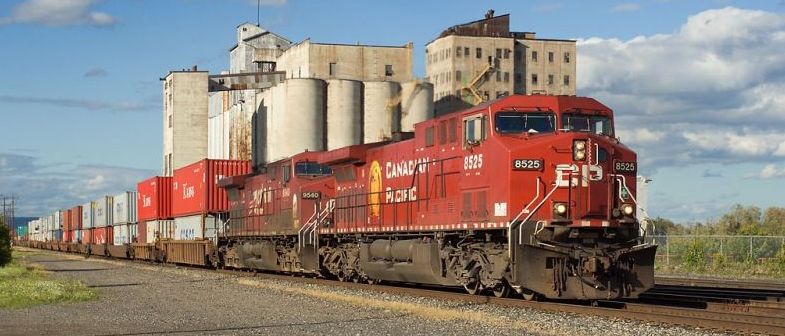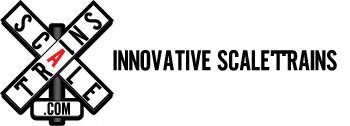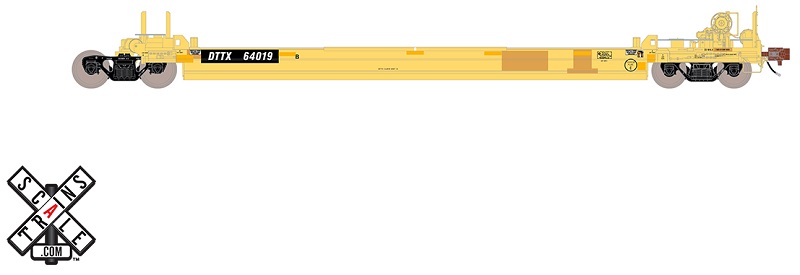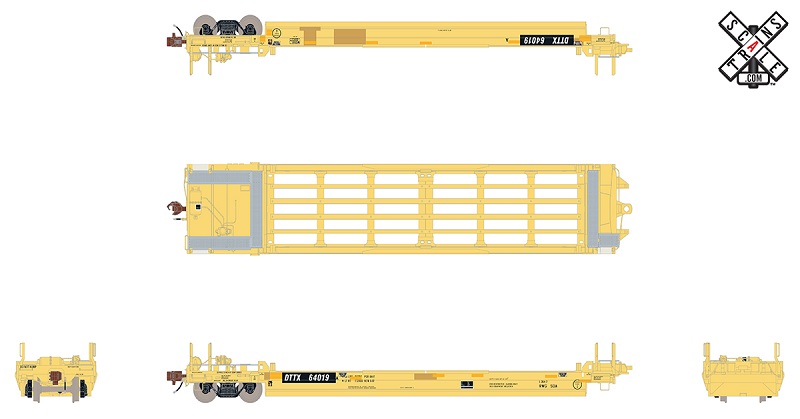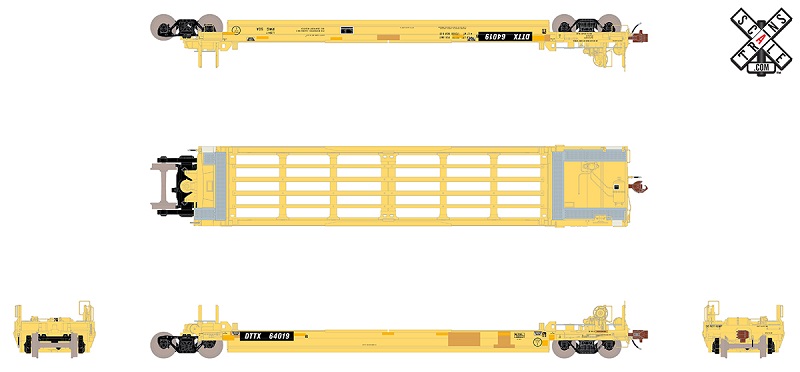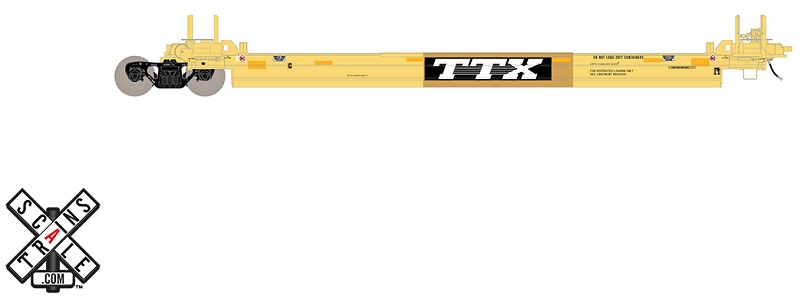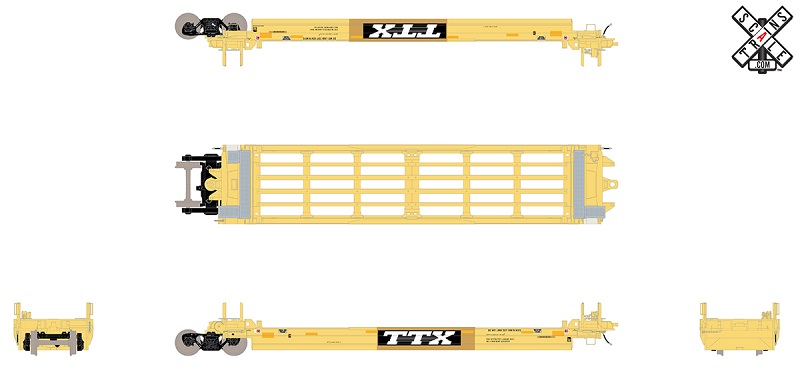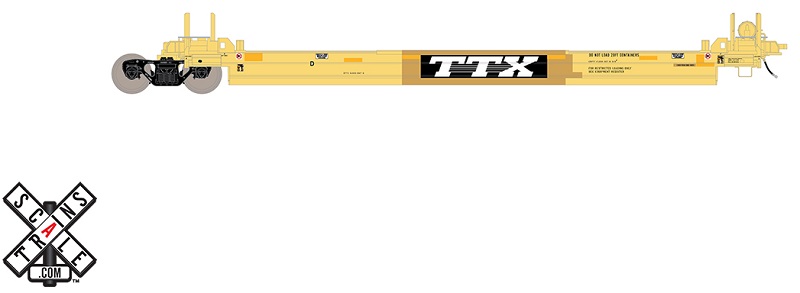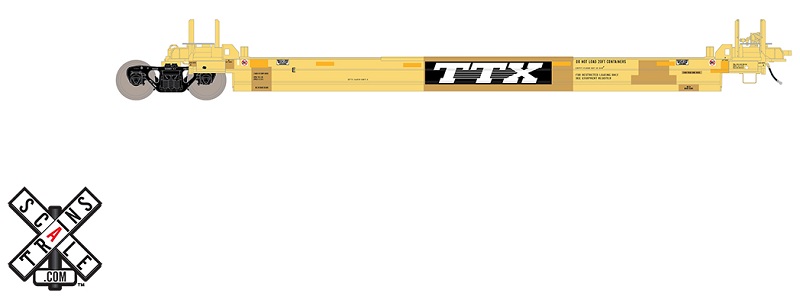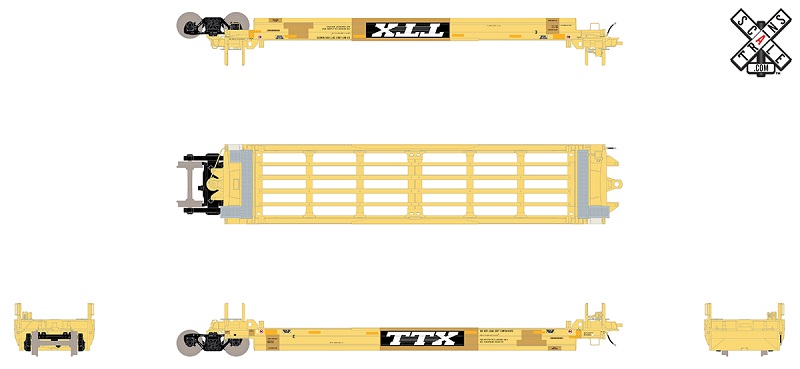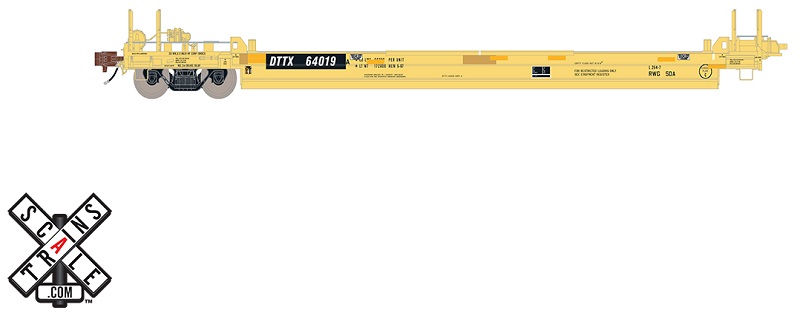Prototype History
With the development of the double-stack well car in the late 1970s, in a joint effort by ACF Industries and Southern Pacific Railroad, a transportation revolution had begun. Quickly realizing the advantages of this new mode of intermodal transport, many freight car builders developed well car designs to meet the demand. The earliest designs, such as the pioneering ACF cars built for SP, and designs built by Thrall and Gunderson, featured “bulkheads” at the end of each well, as well as position-able stops, called “flippers”, to help secure the container loaded in the uppermost position. While effective in their intended role, these bulkheads added additional tare weight, and the flippers additional maintenance. By the mid-80s, with double-stack traffic on the rise, well car designs would evolve again.
Introduced in 1986 by longtime builder Pullman-Standard, the “Backpacker” well car, itself a design originated by freight car supplier Youngstown Steel Door (YSD), was a 5-unit, articulated car featuring 40’ wells, built at Pullman-Standard’s Bessemer, AL facility. With wells having a tapered shape and low profile, at a glance they looked similar to offerings from competitor Gunderson, but much shorter in height.
Building upon lessons learned up to that point, the new car sought to reduce tare weight by eliminating the bulkheads found on earlier designs, relying on Inter-Box Connectors (IBCs) installed at the upper corners of the container loaded in each well. Similar to the methods used to secure containers loaded on container ships, the IBCs locked the top container in place, with the elimination of the heavy bulkheads ultimately helping the railroads’ bottom line in fuel savings.
While the earliest Backpacker production had limitations on container loading … the middle three wells (units C, D, and E) could not handle pairs of 20’ containers, which are typically heavier than a single 40’ … later production would feature strengthened wells, allowing pairs of 20’ containers to be loaded in all units. On all Backpacker production, all five units could handle a 40’, 45’ or 48’ container loaded in the top position, with 53’ containers possible “staggered” in every other well in the top position.
Proving successful, the Backpacker design would be purchased in quantity by Trailer Train, with multiple orders throughout the latter-half of the 1980s. While Pullman-Standard would be absorbed by rival Trinity Industries, the design would remain unchanged for the time being, with the only notable difference being Trinity builder logos in addition to P-S logos. While individual railroad ownership of intermodal well cars was relatively rare, with most roads content to rely upon the pool of Trailer Train equipment, Burlington Northern would buck that trend, acquiring a small fleet of Backpackers. Painted in BN’s Cascade Green, this small group of Backpackers stood out from the national fleet of yellow Trailer Train cars.
Aside from the BN green cars, all other Backpackers came delivered in Trailer Train yellow, with “TT” and “Trailer Train” logos and branding. Some cars, however, would feature additional logos and lettering for intended assignments to some steamship lines or railroads. Several groups of Backpackers could be found with Japanese container shipping giant “K” Line logos in addition to the Trailer Train branding. Another group would feature logos for the partnership between “K” Line and RailBridge Corporation, another would feature the logos of Danish carrier Maersk, and a small group of cars would feature sub lettering for Southern Pacific Railroad. Into the 1990s, however, this practice of sub lettering would cease, with the steamship company or railroad lettering eventually painted over in most cases.
By 1991, another change in the appearance of the Backpacker fleet would arrive in the form of Trailer Train changing their branding to TTX Co., and the adoption of a new black-and-white striped TTX “speed” logo. The original Trailer Train branding and “TT” logos were painted over and “patched” with this new logo, though a handful of stragglers would last into the 2000s with their original lettering and logos.
In 2008, TTX would change their image yet again, debuting a new stylized TTX logo in Tuscan red, as a nod to the Pennsylvania Railroad, which helped create Trailer Train. As of this writing, several examples of Backpackers have been noted “patched” with this new logo. As for Backpacker purchaser Burlington Northern, their fleet would go on to successor BNSF, eventually gaining new BNSF reporting marks and numbers “patched” over their former BN identities.
As of this writing, most TTX Backpackers are in service, though thanks to the small size of the fleet, seemingly lost among the many other types of well cars owned by TTX. However, they are still relatively young for a freight car, and are still very useful on lanes handling 20’ and 40’ international container traffic.
Road Number Specific ScaleTrains
- Era: 2000s to present
- FRA-224 yellow conspicuity striping
- Road number DTTX 64011
- Series DTTX 64005-64016
- Class RWG50A, built 5/6-87, lot 2017
- Patched with small TTX “Speed Logos”
- Road number DTTX 64019
- Series DTTX 64017-64020
- Class RWG50B, built 6-87, lot 2017
- Patched with large TTX “Speed Logos”
- Road number DTTX 64040
- Series DTTX 64021-64044
- Class RWG50A, built 8/12-87, Lot 2024A
- Patched with small TTX “Speed Logos”
- Road number 64060
- Series DTTX 64055-64069
- Class RWG50C, built 8-88, Lot 2065
- Patched with small TTX “Speed Logos”
- Road number 64066
- Series DTTX 64055-64069
- Class RWG50C, built 8-88, Lot 2065
- Patched with large TTX “Speed Logos”
- Fully-assembled
- Multiple road numbers
- Articulated 5-unit well car built by Pullman-Standard (P-S), later Trinity (TRN)
- Capable of carrying 1 x 40’ or 2 x 20’ containers per well, with up to 48’ long container in top position per well (53’ containers possible in top position, staggered in every other well)
- Diecast bodies for optimum weight and performance
- Photo-etched stainless-steel see-through walkways
- Wire grab irons on side and end sills
- Durable Celcon corner uprights and vertical grabs
- Detailed floors and well interior sidewalls
- Separate Inter-Box Connector (IBC) details included for loading in IBC holder boxes on car deck
- Factory-applied metal grab irons, coupler cut levers, and trainline hoses
- Durable die-cast metal semi-scale Type E lower shelf couplers
- Barber S-2 Roller-bearing 70-ton trucks with 33” wheels at ends; Barber S-2 100-ton trucks with 36” wheels at articulation points
- Accurately profiled and machined .110″ tread metal wheels with accurate contours on the face and back of the wheel; tapered metal axles
- Rotating bearing caps
- Intricate multi-piece brake plumbing and rigging
- Printing and lettering legible even under magnification
- Weighted to Industry standards for reliable operation
- Operates on Code 70, 83, and 100 rail
- Packaging safely stores model and single 40’ standard height or 2 x 20’ containers loaded per well (containers not included)
- Operator series 40’ Containers available separately
- Minimum radius: 22” (without customer-applied brake details parts installed)
- Recommended radius: 26” (with included customer-applied brake detail parts installed)
Order Due Date: June 28, 2021
Anticipated Delivery Date: February 2022
